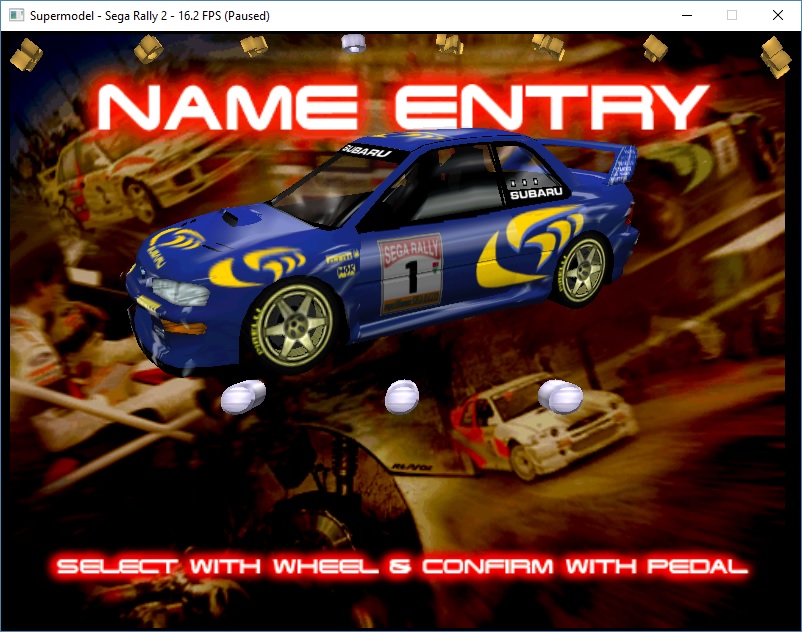Quad rendering bug
Forum rules
Keep it classy!
Keep it classy!
- No ROM requests or links.
- Do not ask to be a play tester.
- Do not ask about release dates.
- No drama!
Re: Quad rendering bug
Well,
this isn't 100% perfect, but maybe the closest we can emulate ..

this isn't 100% perfect, but maybe the closest we can emulate ..

- Ian
- Posts: 2044
- Joined: Tue Feb 23, 2016 9:23 am
Re: Quad rendering bug
Excellent, can't wait to test it! 
-

HarryTuttle - Posts: 646
- Joined: Thu Mar 09, 2017 8:57 am
Re: Quad rendering bug
I'll push it in a bit, need to tidy a few bits up
- Ian
- Posts: 2044
- Joined: Tue Feb 23, 2016 9:23 am
Re: Quad rendering bug
Try it for yourself and see what you think before I push it ..
header file
- Code: Select all
void CNew3D::GenerateVertex(Vertex &newVertex, const R3DPoly& poly)
{
newVertex.color[0] = (poly.v[0].color[0] + poly.v[1].color[0] + poly.v[2].color[0] + poly.v[3].color[0]) / 4;
newVertex.color[1] = (poly.v[0].color[1] + poly.v[1].color[1] + poly.v[2].color[1] + poly.v[3].color[1]) / 4;
newVertex.color[2] = (poly.v[0].color[2] + poly.v[1].color[2] + poly.v[2].color[2] + poly.v[3].color[2]) / 4;
newVertex.color[3] = (poly.v[0].color[3] + poly.v[1].color[3] + poly.v[2].color[3] + poly.v[3].color[3]) / 4;
newVertex.normal[0] = (poly.v[0].normal[0] + poly.v[1].normal[0] + poly.v[2].normal[0] + poly.v[3].normal[0]) / 4;
newVertex.normal[1] = (poly.v[0].normal[1] + poly.v[1].normal[1] + poly.v[2].normal[1] + poly.v[3].normal[1]) / 4;
newVertex.normal[2] = (poly.v[0].normal[2] + poly.v[1].normal[2] + poly.v[2].normal[2] + poly.v[3].normal[2]) / 4;
newVertex.pos[0] = (poly.v[0].pos[0] + poly.v[1].pos[0] + poly.v[2].pos[0] + poly.v[3].pos[0]) / 4;
newVertex.pos[1] = (poly.v[0].pos[1] + poly.v[1].pos[1] + poly.v[2].pos[1] + poly.v[3].pos[1]) / 4;
newVertex.pos[2] = (poly.v[0].pos[2] + poly.v[1].pos[2] + poly.v[2].pos[2] + poly.v[3].pos[2]) / 4;
newVertex.texcoords[0] = (poly.v[0].texcoords[0] + poly.v[1].texcoords[0] + poly.v[2].texcoords[0] + poly.v[3].texcoords[0]) / 4;
newVertex.texcoords[1] = (poly.v[0].texcoords[1] + poly.v[1].texcoords[1] + poly.v[2].texcoords[1] + poly.v[3].texcoords[1]) / 4;
}
void CNew3D::AddTriangle(const Vertex& v1, const Vertex& v2, const Vertex& v3, const R3DPoly& r3dPoly, std::vector<Poly>& polyArray)
{
//=====
Poly p;
//=====
p.p1 = v1;
p.p2 = v2;
p.p3 = v3;
//multiply face attributes with vertex attributes if required
for (int i = 0; i < 4; i++) {
p.p1.color[i] = p.p1.color[i] * r3dPoly.faceColour[i];
p.p2.color[i] = p.p2.color[i] * r3dPoly.faceColour[i];
p.p3.color[i] = p.p3.color[i] * r3dPoly.faceColour[i];
}
polyArray.emplace_back(p);
}
void CNew3D::CopyVertexData(const R3DPoly& r3dPoly, std::vector<Poly>& polyArray)
{
//====================
V3::Vec3 normal;
float dotProd;
bool clockWise;
//====================
V3::createNormal(r3dPoly.v[0].pos, r3dPoly.v[1].pos, r3dPoly.v[2].pos, normal);
dotProd = V3::dotProduct(normal, r3dPoly.faceNormal);
clockWise = dotProd >= 0;
if (r3dPoly.number == 3) {
if (clockWise) {
AddTriangle(r3dPoly.v[0], r3dPoly.v[1], r3dPoly.v[2], r3dPoly, polyArray);
}
else {
AddTriangle(r3dPoly.v[2], r3dPoly.v[1], r3dPoly.v[0], r3dPoly, polyArray);
}
}
else if (r3dPoly.number == 4) {
//=================
Vertex newVertex;
bool clockWise2;
//=================
// check for the evil quads that overlap themselves and change the winding ..
V3::createNormal(r3dPoly.v[0].pos, r3dPoly.v[2].pos, r3dPoly.v[3].pos, normal);
dotProd = V3::dotProduct(normal, r3dPoly.faceNormal);
clockWise2 = dotProd >= 0;
if (clockWise != clockWise2) {
if (clockWise) {
AddTriangle(r3dPoly.v[0], r3dPoly.v[1], r3dPoly.v[2], r3dPoly, polyArray);
}
else {
AddTriangle(r3dPoly.v[2], r3dPoly.v[1], r3dPoly.v[0], r3dPoly, polyArray);
}
if (clockWise2) {
AddTriangle(r3dPoly.v[0], r3dPoly.v[2], r3dPoly.v[3], r3dPoly, polyArray);
}
else {
AddTriangle(r3dPoly.v[0], r3dPoly.v[3], r3dPoly.v[2], r3dPoly, polyArray);
}
return;
}
GenerateVertex(newVertex, r3dPoly);
if (clockWise) {
AddTriangle(r3dPoly.v[0], r3dPoly.v[1], newVertex, r3dPoly, polyArray);
AddTriangle(r3dPoly.v[1], r3dPoly.v[2], newVertex, r3dPoly, polyArray);
AddTriangle(r3dPoly.v[2], r3dPoly.v[3], newVertex, r3dPoly, polyArray);
AddTriangle(r3dPoly.v[3], r3dPoly.v[0], newVertex, r3dPoly, polyArray);
}
else {
AddTriangle(r3dPoly.v[0], r3dPoly.v[3], newVertex, r3dPoly, polyArray);
AddTriangle(r3dPoly.v[3], r3dPoly.v[2], newVertex, r3dPoly, polyArray);
AddTriangle(r3dPoly.v[2], r3dPoly.v[1], newVertex, r3dPoly, polyArray);
AddTriangle(r3dPoly.v[1], r3dPoly.v[0], newVertex, r3dPoly, polyArray);
}
}
}
header file
- Code: Select all
void GenerateVertex(Vertex &newVertex, const R3DPoly& poly);
void AddTriangle(const Vertex& v1, const Vertex& v2, const Vertex& v3, const R3DPoly& r3dPoly, std::vector<Poly>& polyArray);
- Ian
- Posts: 2044
- Joined: Tue Feb 23, 2016 9:23 am
Re: Quad rendering bug
I honestly think that the version where we flipped the split was more accurate
Maybe I could use this method to try that..
Maybe I could use this method to try that..
- Ian
- Posts: 2044
- Joined: Tue Feb 23, 2016 9:23 am
Re: Quad rendering bug
Ok. I'll let you know, in case I'll upload some new screenshots.
-

HarryTuttle - Posts: 646
- Joined: Thu Mar 09, 2017 8:57 am
Re: Quad rendering bug
Ian wrote:I honestly think that the version where we flipped the split was more accurate
Maybe I could use this method to try that..
I think you're right about the accuracy of the flipped split, in fact in many cases the specular has a sort of "diamond" shape. I checked by reloading the savestates used to produce the former series of screenshots of Harley and Dirt Devils (however Scud is more close to the original). Tomorrow I'll upload some example.
There must be some sort of condition that triggers the split flipping. In one of my tests I noticed that sometimes, in the same quad, the normal of a triangle built from vertices 0,1,2 is different from the one build from vertices 1,2,3 (flipped split). In that case, after being multiplied by the same face normal, they'll generate different winding. Could be a sort of hint?
I saw also, from the link you posted, that one can use the geometry shader to create a quad, but GPUs older than opengl 3.2 are out of luck.
-

HarryTuttle - Posts: 646
- Joined: Thu Mar 09, 2017 8:57 am
Re: Quad rendering bug
Yeah, well increase the vertex count is a good approximation
But the hardware is doing something else ..
But the hardware is doing something else ..
- Ian
- Posts: 2044
- Joined: Tue Feb 23, 2016 9:23 am
Re: Quad rendering bug
Just a quick update with some screenshots of "bad" quads with the new method:
Ian, based on the geometry shader solution you linked: http://www.informit.com/articles/article.aspx?p=2120983&seqNum=2, I wonder if could be possible to send those quad vertex data (color, texture coordinates and normals) as uniforms in fragment and vertex shader to obtain the same effect.
Ian, based on the geometry shader solution you linked: http://www.informit.com/articles/article.aspx?p=2120983&seqNum=2, I wonder if could be possible to send those quad vertex data (color, texture coordinates and normals) as uniforms in fragment and vertex shader to obtain the same effect.
-

HarryTuttle - Posts: 646
- Joined: Thu Mar 09, 2017 8:57 am
Who is online
Users browsing this forum: No registered users and 1 guest

